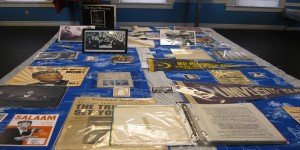Chaminade University welcomed the Black History 101 Mobile Museum for the week of March 12-16. The museum is lead by Khalid el-Hakim and Professor Griff.
El-Hakim has been collecting the artifacts that make up the museum for the past 21 years dating back to the beginning of the museum. He has a deep fondness for preserving historical artifacts and sharing it with individuals to bridge the gap in the lack of knowledge amongst individuals. El-Hakim has been touring for 12 years, seven years nationally. All the artifacts in the museum are unique to the Black History 101 Mobile Museum.
“I started the Black History 101 Mobile Museum because many people have only a cursory knowledge of the history of African-Americans,” said Khalid el-Hakim, founder and curator of the Black History 101 Mobile Museum. “In 2012 there are still many gaps in K-12 history books about the contributions of African American.”
The mission of the mobile museum is to raise the consciousness of the human family by sharing artifacts that celebrate the contributions, achievements and experiences of African Americans. As El-Hakim has realized the lack of knowledge in college students about black history he hopes that through touring the Black History 101 Mobile Museum on college campuses that will change.
“Even on many of the college campuses many students have not been taught more than the basics on slavery and the Civil Rights Movement,” el-Hakim said.

In the seven years of touring nationally the Black History 101 Mobile Museum has visited approximately 50 universities.
El-Hakim also wants people to gain an appreciation of some of the untold stories in American history and become inspired to explore what they have learned from the exhibit on a deeper level. As black history has not been taught in every school around the world it is where all history began.
“The history of the whole human family begins with the Black man and woman so if history doesn’t respect black history then all of history is well skewed, El-Hakim said.
The artifacts that El-Hakim has for the tabletop display have not been cared for enough by the previous owners and have ended up in antique shops where he purchases them. People do not see the value of the pieces until they have seen they placed in relation to black history and hear the story the artifact tells when it is coupled with other artifacts that have historical value.
All history does not have to be about struggling with race; it also has to do with the freedom of expression in writing or any form of entertainment. A part of the Black History 101 Mobile Museum speaks on the history of music.
“Students are exposed to artifacts that put musical artists into a proper historical context. For example, many students haven’t heard of Public Enemy but they know who Flava Flav is which, is a shame,” El-Hakim said. “Fortunately, we have original artifacts from Public Enemy that puts Flava Flav in a perspective goes beyond what people have viewed on VH1.”
El-Hakim remains driven by the reality that there is a critical need that people understand the contributions of African-Americans.
“The museum helps to identify stereotypes that have been used to dehumanize African Americans and celebrates those individuals who have sacrificed their lives to improve the conditions of people,” el-Hakim said.
While not everyone is accepting of the raw history that is placed in their view they look at it anyway. Although people do not want to be faced with the adversity in America, the mobile museum forces people to look at the realities of America to deal with the current issues today.
The mobile museum has ended on a positive note at Chaminade.
“It has exceeded my expectations. There was consistent flow of students and community members each day,” el-Hakim said.